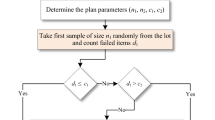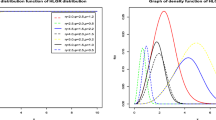Abstract
We consider the Bayesian analysis of lifetime data obtained from multi-component series systems when lifetime of each component of the system follows a ‘family of lifetime distributions’. We obtain Bayes estimates of parameters included in this family using incomplete system lifetime data under competing risk model. In order to show the applicability of results to the real life problems, we present analysis of a real data set of electric appliances in which failures occur due to several causes. We also give an ad-hoc technique to generate sample observations from a complicated distribution.






Similar content being viewed by others
References
Chaturvedi A, Tomer SK (2003) UMVU estimation of the reliability functions of the generalized life distributions. Stat Pap 44:301–313
Gelfand AE, Smith AFM (1990) Sampling-based approaches to calculating marginal densities. J Am Stat Assoc 85:398–409
Geman S, Geman D (1984) Stochastic relaxation, Gibbs distributions, and the Bayesian restoration of images. IEEE Trans Pattern Anal Mach Intell 6:721–741
Gewek J (1992) Evaluating the accuracy of sampling-based approaches to the calculation of posterior moments. In: Bernardo JM, Smith AFM, David AP, Berger JO (eds) Bayesian statistics 4. Oxford University Press, New York, pp 169–193
Kuo L, Yang TE (2000) Bayesian reliability modeling for masked system lifetime data. Stat Probab Lett 47:229–241
Lawless JF (1982) Statistical models and methods for lifetime data. Wiley, USA
Lin DKJ, Usher JS, Guess FM (1993) Exact maximum likelihood estimation using masked data. IEEE Trans Reliab 42:631–635
Martz HF, Waller RA (1982) Bayesian reliability analysis. Wiley, New York
Miyakawa M (1984) Analysis of incomplete data in a competing risks model. IEEE Trans Reliab 33:293–296
Mukhopadhyay C, Basu AP (1993) Maximum likelihood and Bayesian analysis of masked system failure data: k independent exponentials. Technical Report, 517, Department of Statistics, The Ohio State University
Mukhopadhyay C, Basu AP (1997) Bayesian analysis of incomplete time and cause of failure data. J Stat Plan Inference 59:79–100
Mukhopadhyay C, Basu S (2007) Bayesian analysis of masked series system lifetime data. Commun Stat Theory Methods 36:329348
Nelson W (1982) Applied life data analysis. Wiley, New York
Park C (2005) Parameter estimation of incomplete data in competing risks using the EM algorithm. IEEE Trans Reliab 54:282–290
Reiser B, Guttman I, Lin DKJ, Guess FM, Usher JS (1995) Bayesian inference for masked system lifetime data. J R Stat Soc Ser C 44:79–90
Robert CP, Casella G (2010) Introducing Monte Carlo methods with R. Springer, New York
Singh AK, Tomer SK (2011) Maximum likelihood estimation of component reliability using masked series system lifetime data. Calcutta Stat Assoc Bull 63:249–252
Sinha SK (1986) Reliability and life testing. Wiley Eastern Ltd, New Delhi
Tanner MA, Wong WH (1987) The calculation of posterior distributions by data augmentation. J Am Stat Assoc 82:398
Usher JS (1996) Weibull component reliability-prediction in the presence of masked Data. IEEE Trans Reliab 45:229–232
Usher JS, Hodgson TJ (1988) Maximum likelihood analysis of component reliability using masked system life-test data. IEEE Trans Reliab 37:550–555
Xu A, Tang Y (2009) Bayesian analysis of Pareto reliability with dependent masked data. IEEE Trans Reliab 58:583–588
Acknowledgments
The authors are grateful to the referee and the editor Prof. Uday Kumar for their helpful suggestions that greatly improved the original manuscript. The last author acknowledges with thanks the financial support of University Grant Commission, New Delhi, India.
Author information
Authors and Affiliations
Corresponding author
Appendix: An ad-hoc numerical technique for generating sample observations
Appendix: An ad-hoc numerical technique for generating sample observations
Here we propose a technique for generating sample observations from a very complicated or improper probability density function. This is a parallel attempt to the traditional inverse transformation technique. The technique may be useful while using Gibbs sampler since in most of the cases the full conditionals used appear in the proportionality form. The only requirement for the technique here is that the density under consideration should be log-concave. We propose the technique as follows.
Let f(y) is a log-concave (density) function of y, then the integral from −∞ to c (say) may be finite, where c is a sufficiently large value of y. The choice of c is done such that the integral −∞ to c takes a constant value ϕ and we do not observe any further increment in ϕ on increasing the c, that is
Now we generate a random number U in the range [0, ϕ] and use it as a support for sample generation as follows.
Now, we solve the integral (2) numerically to get the value of z. For the numerical solution, we divide the range of variable in very small intervals (depends on accuracy required) and find the ordinate for which calculated integral value is nearest to U. This ordinate is a required sample observation from the considered density function. For generating another sample value we generate another U and solve (2) again. Proceeding this way a sample of required length may be obtained from the density f(y).
The algorithm for simulating sample using this technique is as follows.
-
Step 1 Calculate the area ϕ under the curve f(y) for sufficiently large value of variable y such that it (area) becomes constant with respect to further increment in y.
-
Step 2 Generate a uniform random variate U in the range [0, ϕ].
-
Step 3 Find a sample observation z by solving (2) numerically.
-
Step 4 Go to Step 2 and follow steps 2 and 3 to generate more observations.
Rights and permissions
About this article
Cite this article
Tomer, S.K., Singh, A.K. & Panwar, M.S. Bayesian analysis of masked series system lifetime data from a family of lifetime distributions. Int J Syst Assur Eng Manag 5, 495–502 (2014). https://doi.org/10.1007/s13198-013-0191-4
Received:
Revised:
Published:
Issue Date:
DOI: https://doi.org/10.1007/s13198-013-0191-4
Keywords
- Masked data
- Generalized lifetime distribution
- Gibbs sampler
- Bayes estimate
- Latent variable
- Augmented likelihood




